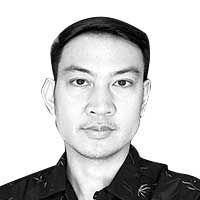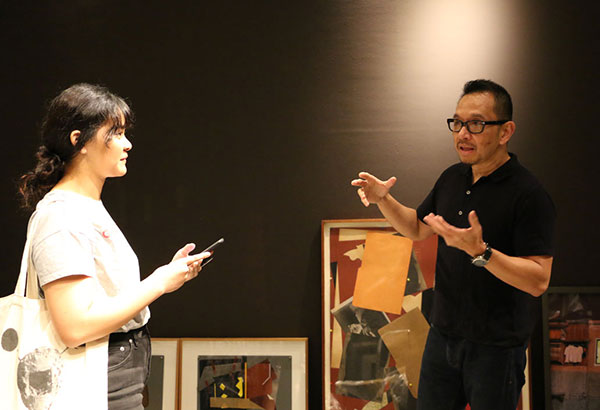The curator is present


New York-based jeweler, exhibition designer, merchant, collector, and publisher Federico de Vera explains his curatorial practice behind his eponymous exhibition at the Ayala Museum opening tomorrow.
The role of the curator has never been more central to the conversation of contemporary art. When before they would usually take a backseat and let the exhibition speak for itself, now they are nearly as known as the artists whose works they curate, attending conference, speaking in public fora, circulating in the art world. As public intellectuals and powerful gatekeepers, they decide on what kind of art gets shown, perpetuated, written about, and ultimately collected.
For the upcoming exhibition at the Ayala Museum, the curator is the central figure around whom the works orbit, held in place by the gravity of his taste. “Curated by Federico de Vera,” which formally opens to the public tomorrow (Nov. 7) and will run until Jan. 28, 2018, displays over 300 paintings, artifacts, religious objects and objets d’art all carefully selected and filtered through the sensibility of De Vera. The title of the exhibit alone conveys that the curator is present, if not omnipresent. “If I am curating something, it has to be 100 percent mine,” he says.
A native of Dagupan City, Pangasinan, De Vera finished a degree in architecture at the University of Santo Tomas before moving to the United States. On the West Coast, he realized that he had a knack for arranging and designing things, combing through flea markets for beautiful, one-of-a-kind pieces. It was in New York that his fame as “a purveyor of fine things” grew when he established a shop on Crosby Street in Manhattan. The New York Times described him as “aesthetic savant” and “design alchemist.”
Soon, de Vera was expanding his reach to include book publishing and curating. Last year, he curated “Pinto: Manhattan Manila,” which brought the best of the Philippine contemporary art to the East Coast. Almost all the paintings got sold. Earlier, in 2014, he put together “Egon Schiele: Portraits,” which was shown at Neue Gallery, also New York.
Not one to drop opaque academic references, De Vera curates from a sincere belief in beauty, guided by the criterion that the objects he displays must “have absolutely nothing wrong with them.” He knows that he has been successfully able to pull off a show when the viewer sees “what’s related to what, (whether) it’s the form or the theme — the stuff that connects them all together.”
For this exhibition, possibly the largest that the De Vera has overseen, he arranges the works based on three major themes, with each presented on a floor of the museum. These are: “Portrait of the Filipino,” “Treasury” and “Art and Design.”
On the ground floor, De Vera highlights the many faces the Filipino, as interpreted by a diverse number of artists, from Ang Kiukok to Ronald Ventura to Winner Jumalon. “In this section, I wanted a very visual and pictorial depiction of how there are so many Filipinos —Chinese, American, Spanish, dark, fair-skinned, rich, poor,” he says. “They are who and what the paintings represent, and why this gallery displays mostly portraits. These are complemented by landscapes, scenes of war, destruction, daily life, showing our shared experience and what goes on in Filipino psyche.”
On the second floor, he shines a spotlight on the beautiful objects connected to our Catholic tradition. “In stark contrast to some of the poverty shown at the ground floor gallery,” he continues, “here you see in this space how rich we are as well. Each object found here will make you say, ‘Wow!’ — from the ivory heads, vestments, crucifixes, among others. Here, we also explore the major influence of Christianity: how it brought about richness, conflict and beauty.”
On the third floor, De Vera allows the ethnic and the contemporary, the old and the new, to converse. “Here, ethnographical objects show how ethnic design and modern and contemporary art are somewhat related, and some artists have bravely veered away from the figurative and produce something that can still be considered meaningful,” he says. “This section also showcases the functional and the natural, which make you ponder, ‘Can this be art, too?’”
Complementing the exhibition is a full-color catalogue (“an artwork in itself,” describes De Vera) featuring all the works and the essays by art and culture luminaries that include Felice Sta. Maria, Lisa Periquet, and Dr. Joven Cuanang, who shed light on matters of collecting, connoisseurship, and scholarship.
To bring together all these works — loaned from different collectors — in a single space is a feat in itself, and it’s interesting to see how De Vera is able to weave them together in a narrative of our culture which he describes as “the product of diversity and tenacity,” that is at once “dense and spontaneous.” Today, the curator is many things, certainly, but what De Vera brings back to the conversation is that he, too, is an arbiter of taste.



















